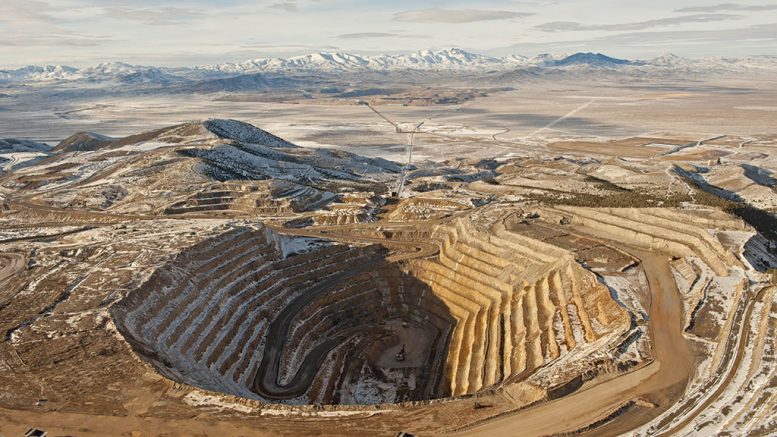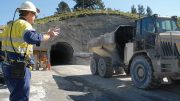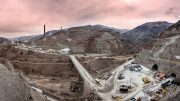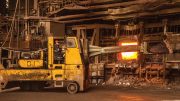The past year was a time of growth and transformation for many mining and exploration companies. Here’s a list of eight companies with milestones to hit next year.
Barrick Gold

Barrick Gold’s Cortez gold mine, 100 km southwest of Elko, Nevada. Credit: Barrick Gold.
Barrick Gold (TSX: ABX, NYSE: GOLD), one of the world’s largest gold miners, has operations in the U.S., Canada, the Dominican Republic, Argentina, Papua New Guinea, Africa, Australia, South America and Saudi Arabia.
This year, consolidated production is expected at 5.1 million to 5.6 million oz. gold at all-in sustaining costs (AISCs) of US$870 to US$920 per ounce. In addition, copper production is forecast to reach 375 million lb. to 430 million lb. at AISCs of US$2.40 to US$2.90 per pound. These figures exclude the impact of the Nevada joint-venture formation.
Over the next five years, the company anticipates similar gold production with declining AISCs.
At the company’s flagship Nevada operations, the Nevada Gold Mines joint-venture transaction closed in July. Barrick holds a 61.5% ownership (38.5% Newmont Goldcorp [TSX: NGT, NYSE: NEM]) and is the operator. The venture includes a total of 10 underground and 12 open-pit mines, including Cortez, Goldrush, Carlin and Twin Creeks. Over the next five years, the group is expected to produce 3.5 million oz. to 3.8 million oz. gold per year. Nevada Gold Mines’ reserves stand at 48.3 million ounces.
Over the past year and a half, Barrick has been active on the corporate development front.
Most recently, the company announced the sale of its Massawa gold project in Senegal to Teranga Gold (TSX: TGZ) for US$300 million in cash, US$80 million of stock and up to US$50 million in contingent payments.
The formation of Nevada Gold mines, announced in March, came as a result of the company’s rejected hostile takeover bid for Newmont Mining, first announced in February.
In September 2018, Barrick and Africa-focused Randgold Resources announced a merger. The transaction added the Loulo-Gounkoto and Morila mines in Mali, the Tongon mine in Côte d’Ivoire and the Kibali mine in the Democratic Republic of the Congo to the portfolio.
In October, Barrick announced that its Hemlo operations in Ontario are being refocused with a phase out of the open-pit operation and a move to underground contract mining.
Barrick Gold has a current market capitalization of approximately $40.3 billion.
Cordoba Minerals

A drill crew at Cordoba Minerals and HPX’s San Matias copper-gold project in northern Colombia. Credit: Cordoba Minerals.
Cordoba Minerals (TSXV: CDB) is focused on advancing the San Matias copper-gold-silver project in Colombia. The Alacran deposit at the site features mineralization traced over 1.3 km of strike.
The 149 sq. km San Matias project is 390 km northwest of Bogota and within an established mining district. Cordoba acquired the project in 2015.
In July, Cordoba released a preliminary economic assessment and an updated mineral resource estimate for the project.
The study envisions an 8,000-tonne per-day open-pit operation at the site increasing to 16,000 tonnes per day after a processing plant expansion in the sixth year of operations. The mine would produce copper, gold and silver in a clean copper concentrate and precious metals doré. Annual copper production would average 18,100 tonnes in concentrate at US$1.32 per payable lb. copper net of by-product credits.
Indicated resources for the project stand at 94.9 million tonnes grading 0.71% copper equivalent for a total of 1.08 billion lb. copper, 897,900 oz. gold and 8.2 million oz. silver. Inferred resources total 3.4 million tonnes at 0.45% copper equivalent for a total of 22.9 million lb. copper, 22,400 oz. gold and 142,800 oz. silver.
Most current resources are contained within the Alacran deposit. Upside beyond the current resource inventory is from exploring both the potential underlying copper-gold porphyry source as well as from the possible northern extension of the deposit.
In addition, the Willan target, 6 km south of Alacran, features similar stratigraphy with past outcrop sampling returning up to 8.95% copper.
In May, Cordoba suspended diamond drilling at the project due to potential security concerns raised by employees and contractors who received demands and threats. The company has been working with various levels of government and the military to resolve the issue. In August, Cordoba announced that Colombia’s national mining agency approved its request to suspend all obligations relating to the El Alacran title until May 23, 2020.
Cordoba also holds a 25% interest in the 52 sq. km Perseverance copper project in Arizona (75% Bell Copper [TSXV: BCU] through an earn-in and joint-venture agreement), with the option to increase its participation to 80%. The claims are located close to the Wheeler Wash porphyry root zone.
Cordoba Minerals has a market capitalization of approximately $36.5 million.
Erdene Resource Development

Drilling at Erdene Resource Development’s Altan Nar gold-polymetallic project in southwestern Mongolia. Credit: Erdene Gold Development video screenshot.
Erdene Resource Development (TSX: ERD) is focused on developing the Khundii gold project in Mongolia. Khundii is 300 km south of the regional capital and consists of the Bayan Khundii and Altan Nar deposits, which are located 16 km apart.
In October, Erdene released the results of a technical report for the Khundii open-pit project, which incorporated results of a prefeasibility study on the Bayan Khundii deposit and an updated preliminary economic assessment for the Altan Nar deposit.
The report envisions a staged 1,800-tonne-per-day open-pit operation with mining first extracting Bayan Khundii over a six-year operating life, and then transitioning to Altan Nar for three years. Bayan Khundii would produce an average of 61,000 oz. annually at AISCs of US$746 per oz., while Altan Nar would yield an average of 48,000 oz. a year at AISCs of US$931 per ounce. Total preproduction capital estimates came in at US$40 million, with another US$2.2 million required for supporting infrastructure at Altan Nar in the sixth year of operations.
Total Khundii measured and indicated resources are at 10.1 million tonnes grading 2.59 grams gold for 839,000 oz. and inferred resources of 4.3 million tonnes at 2.1 grams gold for 289,000 ounces. Bayan Khundii includes reserves of 3.5 million tonnes at 3.73 grams gold.
In October, Erdene announced an $8-million financing package led by the European Bank for Reconstruction and Development, with a convertible loan from the bank of up to US$5 million alongside a $1.6-million private placement.
Looking beyond the deposits, Khundii is located within the central Asian orogenic belt, host to a number of gold and copper deposits. Prospective structures have been found outside of the Bayan Khundii deposit, whereas at Altan Nar, 18 targets have been traced over 5.6 km of strike.
The company is working towards a project development decision next year, with a target of first gold production in 2021.
Erdene has an approximate market capitalization of $32 million.
Goldplay Exploration

Drillers at the Nava gold target on Goldplay Exlporation’s San Marcial property in Sinaloa, Mexico. Credit: Goldplay Exploration.
Goldplay Exploration (TSXV: GPLY) holds 250 sq. km of ground in the Rosario mining district in Mexico’s Sinaloa state.
The San Marcial project is the company’s most advanced asset and is 5.5 km south of First Majestic Silver’s (TSX: FR, NYSE: AG) Plomosas silver project. A resource estimate released in February outlined indicated resources of 7.6 million tonnes grading 147 grams silver equivalent for a total of 36 million equivalent oz. silver. Inferred resources are at 3.4 million tonnes grading 99 equivalent grams silver for a total of 11 million equivalent oz. silver.
The current resource area covers a 500-metre strike length, with eight more exploration targets found within a 6 km long trend.
This year, exploration efforts focused around the Faisanes target nearby the resource site, as well as on the Nava gold target. More work was completed along the corridor between Nava and Faisanes.
Faisanes covers 600 metres of strike; diamond drilling returned a 1-metre intercept grading 204.6 grams gold with channel samples of up to 56 metres at 196 grams silver.
Trenching completed on the Guacamayo target just southeast of the resource returned 24 metres of 219 grams silver earlier this year.
The Nava target is 1.5 km west of the San Marcial resource and represents a potential low-sulphidation epithermal gold system. Work to date has identified a 500-metre-long zone of gold mineralization at Nava. Channel sampling results include 24 metres of 2.1 grams gold in addition to a 1-metre diamond drill intercept grading 354 grams silver.
Sampling of historical San Marcial drill core completed in 2018 has found gold mineralization outside of the projected pit shell.
Goldplay’s focus at San Marcial is on expanding its resource inventory with an updated resource estimate expected in the next six to 12 months, followed by a preliminary economic assessment.
Beyond San Marcial, Goldplay holds the El Habal property, which hosts a 6 km prospective corridor.
Goldplay has a market capitalization of approximately $13 million.
Iamgold

Iamgold’s Rosebel gold mine in Suriname. Photo by The Northern Miner.
Iamgold (TSX: IMG, NYSE: IAG) holds four operating mines, two development assets as well as several exploration projects in its portfolio. This year, production guidance is for 765,000 to 810,000 oz. gold at AISCs of US$1,090 to US$1,130 per ounce.
The Essakane open pit in Burkina Faso is expected to contribute 380,000 to 390,000 oz. this year, with another 240,000 oz. to 260,000 oz. expected from the Rosebel open pit in Suriname.
This December, the company released updated production guidance for its Westwood underground mine in Quebec, which incorporates the impact of a development ramp-up period. Over the next three to four years, the asset is expected to produce 100,000 to 150,000 oz. a year at AISCs of US$1,125 to US$1,225 per ounce. Production on the order of 130,000 to 145,000 oz. annually is expected to follow at AISCs in the range of US$1,000 to US$1,100 per ounce. An updated mine plan and technical report for Westwood are expected in the second quarter of next year.
In addition, Iamgold holds a 41% interest (41% AngloGold Ashanti [NYSE: AU], which is the operator, and 18% for the government of Mali) in the Sadiola open pit.
In November, the company announced the results of a feasibility study on the Essakane carbon-in-leach and heap-leach project. It outlined an 11.7-million-tonne-per-year (mtpa) hard rock operation (versus 10.8 mtpa currently) between 2020 and 2026, with a heap-leach throughput of 8.5 mtpa between 2027 and 2031. Commissioning of the expanded mill is expected in next year’s third quarter. Regional exploration is underway on the property.
In October, the company reported an initial inferred resource of 97 million tonnes grading 1.02 grams gold for a total of 3.2 million oz. for the Nelligan project in Quebec, where it holds a 75% interest (25% Vanstar Mining Resources [TSXV: VSR]). Iamgold holds the option to earn another 5%. Additional drilling is planned to upgrade and extend resources.
Iamgold also holds the Karita exploration project in Guinea, where drilling results released in October confirmed a grassroots discovery. Intercepts included 29 metres of 2.96 grams gold and 21 metres of 9.01 grams gold. Karita is 8 km from the Boto gold project in Senegal, with reserves of 35.1 million tonnes at 1.71 grams gold for a total of 1.9 million ounces.
Iamgold has an approximate $2-billion market capitalization.
Thor Explorations

Employees study drill core at Thor Explorations’ Segilola gold project in Nigeria. Credit: Thor Explorations.
Thor Explorations (TSXV: THX) is focused on building the Segilola open-pit gold mine, 120 km northeast of Lagos in Nigeria.
At the end of May, the company signed the engineering, procurement and construction contract for the Segilola project with Norinco International, a company affiliated with China North Industries Association. The contract features a fixed price of US$67.5 million for the design, engineering, procurement, construction and commissioning of a 650,000-tonn-per-year gold processing plant.
Based on the results of a feasibility study released in February, the project is expected to produce an average of 80,000 oz. gold over a five-year operating life, at life-of-mine AISCs of US$662 per ounce. Based on the construction of a 625,000-tonne-per-year processing plant, the preproduction capital cost estimate came in at US$87 million.
Current project reserves stand at 3.3 million tonnes grading 4.2 grams gold for a total of 448,000 oz., within indicated resources of 4 million tonnes at 4.3 grams gold. Additional inferred resources stand at 2 million tonnes at 4.7 grams gold for a total of 305,000 ounces.
Alongside the feasibility release, Thor provided the results of a preliminary economic assessment on the supplemental underground project at Segilola, which suggests more production of 33,000 oz. annually at AISCs of US$756 per oz., at a US$13-million development capital cost.
The underground resource estimate consists of 100,000 tonnes in the indicated category grading 9.4 grams gold for a total of 28,000 oz., with another 350,000 tonnes in the inferred category grading 7.9 grams gold for 90,000 ounces.
In April, Thor announced a US$78-million financing package for Segilola with Africa Finance Corp., an institution with a focus on private sector infrastructure investment. As of June, 89% of the US$97.6-million project total was funded with the closing of another $15.7-million private placement announced in December.
The Segilola open pit could start production within the next 15 months.
There are opportunities for resource growth at Segilola at depth and on strike. Eight exploration targets areas have been found through soil sampling. In December, the company also announced that it acquired 344 sq. km of exploration licences next to the Segilola project.
Thor also holds the Makosa project in Mali where work is progressing towards a resource estimate, and additional exploration licences in Nigeria. It holds a 49% interest in the Houndé joint venture in Burkina Faso (49% Acacia Mining, acquired by Barrick Gold [TSX: ABX; NYSE: GOLD) in September).
The company has a market capitalization of approximately $56 million.
Victoria Gold

Ore moves through the leach pad stacking system at Eagle. Credit: Victoria Gold.
Victoria Gold (TSXV: VIT) is ramping up its open-pit heap-leach Eagle gold mine in the Yukon. Based on an update provided in November, the mine has produced 10,400 oz. gold and 1,600 oz. silver. Current guidance is for a commercial production announcement in the second quarter of 2020.
In December, Victoria released the results of an updated technical report, prepared to feasibility study level for Eagle. Total preproduction reserves stand at 155 million tonnes grading 0.65 gram gold per tonne for a total of 3.3 million contained ounces. Annual production is estimated to average 220,000 oz. gold at AISCs of US$774 per ounce.
Victoria is investigating the option of year-round stacking to the heap leach pad, practiced at other northern heap-leach operations.
Looking beyond Eagle, there are a number of exploration targets at the company’s 555 sq. km Dublin Gulch property. Raven is located along a large intrusive body — similar to the one hosting the Eagle mine mineralization. Trenching completed in 2018 returned 124 metres of 3.51 grams gold per tonne, with 2019 follow-up work returning 12 metres of 7.91 grams gold and 60 metres of 1.12 grams gold.
Next year, exploration will focus on testing Raven mineralization through a 7,500-metre diamond drill campaign, as well as 3,500 metres of drilling allocated towards the Nugget target area to test for Eagle style mineralization. Additional soil sampling, mapping and sampling is planned for these targets, with a $10-million budget.
Kinross Gold (TSX: K, NYSE: KGC), which owns and operates the Fort Knox heap-leach mine in Alaska, holds 6.5% of Victoria’s shares outstanding.
Victoria Gold has a market capitalization of approximately $500 million.
Wesdome Mines

The Kiena mine site in Val D’Or, Quebec. Credit: Wesdome Gold Mines.
Wesdome Gold Mines (TSX: WDO) is an Ontario and Quebec-focused gold producer. This year, its two operating mines are expected to produce 88,000 to 93,000 oz. gold at AISCs of US$985 to US$1,040 per ounce.
The flagship Eagle River complex, in Wawa, Ont., features two deposits (Eagle river underground and the Mishi open pit) feeding a central 850-tonne-per-day mill. Exploration is ongoing at this site to extend mineralization lenses and identify parallel zones.
At the Kiena mine in Val-d’Or, Que., operations were suspended in 2013. The 65 sq. km site features a permitted mine and 2,000-tonne-per-day mill. Wesdome is proceeding with a $27-million exploration and development program at the site. Five rigs are active with more work allocated to underground development and backfilling.
There are 10 shafts within the Kiena property. In September, Wesdome released updated resources for Kiena: measured and indicated resources total 2.8 million tonnes grading 8.67 grams gold per tonne for a total of 788,100 ounces.Additional inferred resources stand at 2.9 million tonnes grading 8.61 grams gold for 798,100 ounces.
Approximately half of these resource ounces are contained within the higher-grade Kiena Deep A zone. Drills are testing its up- and down-plunge extents. Drilling is also focused on definition work to upgrade existing resources. Ongoing exploration continues to return high-grade intercepts from this zone.
Wesdome is also completing underground development to allow more efficient drilling. Work on a preliminary economic assessment is ongoing, with results expected in the first half of next year. The results will determine the next steps for Kiena and provide insight on a potential mine restart.
The company also holds the Moss Lake property, covering 36 km of strike along the Shebandowan greenstone belt, 100 km west of Thunder Bay in Ontario. The property hosts measured and indicated resources of 1.4 million oz., with additional inferred resources of 1.8 million ounces. Current resources grade 1.1 grams gold.
Wesdome has a current market capitalization of $1.28 billion.






Be the first to comment on "Snapshot 2020: Eight companies making waves in the year ahead"